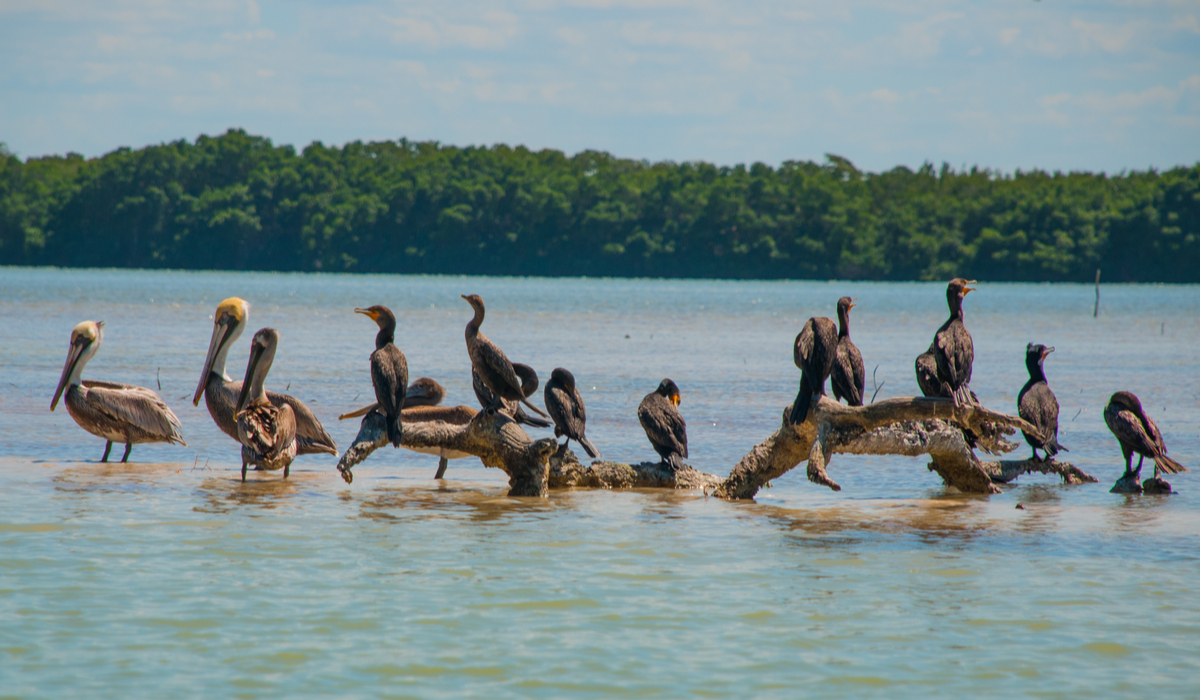Cenotes and Birds – an ecosystem in the Riviera Maya
Most of us are familiar with cenotes, the natural collapses in the Yucatan Peninsula’s karst terrain that serve as windows to the complex aquifer of the region. As the only source of freshwater for the northern portion of the Peninsula they are magnets for all forms of life, particularly birds. In 2001 I began to work with Dr. James Rotenberg, then the director of Science and Avian Studies at the El Eden Ecological Reserve in Northern Quintana Roo. Over the years we have worked together on various projects, and now we are looking for your help to try and understand more about the relationship between birds and cenotes.

Riviera Maya and Yucatan Bird facts
- There are 9,775 species of birds worldwide.
- 1,212, are in imminent danger of disappearing.
- 179 are critically endangered.
- 129 species of birds have become extinct since 1500.
- Mexico has approximately 1000 species of birds making it the #10 country worldwide for bird species.
- There are approximately 540 resident bird species in our study area and 14 of them are endemic.
- There are approximately 220 migrant bird species that pass through this area each spring and fall.
- There are approximately 2 billion migratory birds that use the Yucatan Peninsula yearly as a travel corridor.
- Bird watching is one of the most popular outdoor activities in the United States with over 20 million Americans claiming some interest.
Bird Migration to Mexico and the Riviera Maya
You are a neo-tropical migrant species like the Hooded Warbler (Wilsonia citrina) above. You are a little over 5 inches long and weigh just a few ounces. You summer as far north as Newfoundland in Canada and when autumn comes you head south. You and your flock will gather on the gulf coast of the United States waiting for the break in the weather you need and then head out across the Gulf of Mexico, a non stop flight estimated to be 24-36 hours depending on the size of the bird and the weather conditions. Once reaching the shores of the Yucatan you will be tired, hungry and thirsty. What presents a better opportunity to refuel than a cenote? With year round access to water, the vegetation around cenotes is considerably more healthy than the surrounding jungle. As a result, there is an abundance of food, be it fruit, flowers or insects. When you consider that there are thought to be between 7,000-8,000 cenotes on the Yucatan Peninsula you can easily see how birds and cenotes are so closely linked. With their habitats threatened by development along the coast of the Riviera Maya, it is our intention to develop programs to study the resident and migrant birds of this area and to promote sustainable tourism practices with bird watching tours.
Mexican birds in the Riviera Maya for bird watchers
Our bird study begins in the Riviera Maya
In March of 2005 we began a study in the cenotes of the Ponderosa cave system just to the south of Puerto Aventuras. (your humble Loco Gringo’s Kay and Gary were responsible for much of the exploration of this incredible cave system). Using a precision GPS unit called a RECON, we strike off into the field to collect data.
A typical day for Jamie and me starts early as it is at dawn and twilight when birds are most active. Aided by Jamie’s bird senses and years of fieldwork, we quickly get to work. Thanks to the RECON, I am able to record the observations Jamie would normally take in a notebook right into the unit.
There are some fundamental questions that Dr. Rotenberg is eager to answer. ‘How do different cenote habitats support birds with water, food and other environmental resources compared to other habitats while at the same time supporting sustainable tourism and environmental conservation?
More about the Riviera Maya birding field trips
Alltounative is launching these two unique bird watching excursions this May. This is an amazing opportunity to join internationally-acclaimed ornithologist, Dr. Jamie Rotenberg and be part of a small group of participants (maximum 12 people) who will actively contribute to an on-going scientific study of birds based primarily, but not exclusively, on the freshwater jungle cenote pools of the Riviera Maya in Quintana Roo, Mexico. Not only will you get the opportunity to see exotic birds in their natural habitat, but the data you collect will be used to help scientists understand how these bird species react to changes in their environment due to global warming, deforestation, water quality fluctuations and loss of habitat.
Dr. Rotenberg will demonstrate techniques and instruct the group in the collection of avian field data. Each participant will have “hands-on” opportunities to experience scientific field methods, including area search techniques, observation, bird capture via mist-nets, and the banding of birds.
Participants will visit a variety of habitats extending from the Mexican Caribbean coast to the jungle interior, which differs in geology, hydrology, and ecology. Each unique site supports a similar but different mix of bird species. The group’s study will include over 100 bird species or approximately 1/5 of the bird species found in Mexico’s Yucatan Peninsula. Birds expected to be encountered could include neo-tropical migrants from the US and Canada that spend their winter in the tropics; such as White-eyed Vireo, Painted Bunting, American Redstart, and Magnolia Warbler. Also included will be resident species like the Turquoise-browed Motmot (found at each cenote), Black-headed Trogon, Altamira Oriole, Ferruginous Pygmy-Owl, and several endemic species only found in the Yucatan Peninsula, including the Yucatan Jay, Yucatan Parrot, Yucatan Flycatcher, Yucatan Woodpecker and Orange Oriole. One study focuses on caribbean coastal birds, the other on inland jungle birds.
Check out places to stay in the Riviera Maya that are perfect for birding vacation in the heart of the Sian Ka’an Biosphere and along the Mexican Caribbean.
